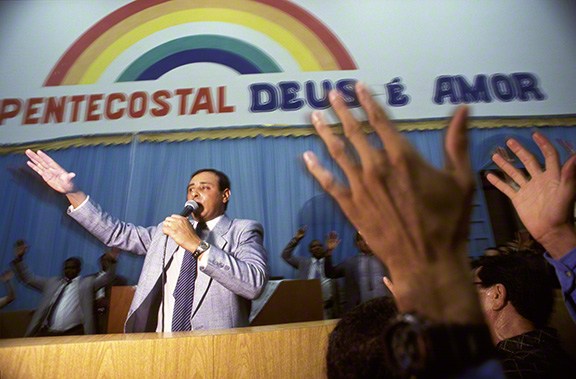As one listens to Dr. Johnson describe the high homicide rates of Río de Janeiro, the gap in between the haves and the have nots, as well as the appalling conditions he witnessed –through use of an admirable methodology– in this city’s prison system, something that stands out clearly is how all these elements are strongly concatenated as pieces of the same dehumanizing setting. It’s not a coincidence that, in several countries within Latin America, scandalous levels of inequality coexist with elevated delinquency rates. Francois Bourguignon (1999) stated that, in developing countries, crime and violence are likely to be a socially costly by-product of, among other factors, uneven or irregular economic development processes, and affirmed that economic theory shows how property crime and, in general, all the violence associated with illegal activity may in part be the consequence of extreme inequality and poverty. This framework of socioeconomic disparity and violence is key to understand how entire population sectors in Río become and remain killable people, and to assess the serious restraints that inmates who proceed from these sectors will face again, once their time in prison is finished. Dr. Johnson refers to Pentecostalism as the faith of the killable and suggests that one of the reasons why Pentecostalism succeeds among those who come from impoverished areas –which is the case of many inmates in Río’s prison system– is that “it can empower people who are, otherwise, thrown into the edges”. In this response, I would like to argue that, in order to appreciate to what extent Pentecostalism could be considered empowering, it’s pertinent to take a look at its impacts (or absence of impacts) in the social context of those who convert to this faith.
Ignacio Martín-Baró (1998) stated that religious conversion has important social implications –even if each person experiences it as an individual process– and that, although conversion brings the knowledge of a new meaning that can make individual life more rewarding, this new meaning can either separate people from their social reality and history, or it can make people become more aware of that reality and turn them into subjects of their own history. Martín-Baró also proposed that the individual motivations for religious conversion acquire a wider historical meaning when they are situated in the net of social forces that affect a person, which can be humanizing or dehumanizing. Taking this into account, if we seek to estimate the empowerment potential of the conversion and affiliation to Pentecostal churches among the inmates of Rio’s prison system, it would be valuable to situate these events in a social background and to inquire: are these conversions able to generate only individual changes in the inmates, or do they also confer on them any resources to bring a positive contribution in the dynamics of their marginalized communities?
Recent research conducted in Central America has attempted to answer a similar question, and has explored the impact of Pentecostal and Charismatic movements on communitarian organization and civic participation. In the case of a traditional Pentecostal church, studied in El Salvador, the research results showed that this faith community conferred high importance upon evangelization and to the individual changes derived from religious conversion, as ways of making a contribution to society; an individualistic view was also present in the way this church interpreted the causes of social problems and in the type of solutions that they considered effective to confront them. In addition, they proved to give utmost importance to the involvement of their members in activities that belonged mostly to the private sphere, without encouraging their interest in the public sphere. Regarding the communitarian participation and political attitudes of the members of this church, it was interesting to find that, from the four faith communities that were studied and compared in El Salvador, the traditional Pentecostals reported the least favorable attitude to political participation in general, the lowest willingness to join political parties or to take over public positions, the strongest reluctance to take part in demonstrations, and a scarce participation in initiatives of their neighborhoods and municipalities. These results, of course, show only coexistence between some religiosity traits and political attitudes –not a cause-effect relation between them– but they suggest that the emphasis this Pentecostal church placed on individual change and on the private space participation didn’t offer favorable conditions for its members to recognize the importance of being active in communitarian organizations and articulating efforts with other citizens to pursue collective goals.
It can be useful to take into account these findings as we go back to considering the social impacts that would be reasonable to expect from the conversion of the inmates in Río´s prison system and from their affiliation to Pentecostal churches. In this sense, it would be interesting to analyze if what Dr. Johnson could observe in the prison churches provided reasons to anticipate that the inmates will, in the future, promote changes beyond their individual behavior and beyond the private space in which religious practice often takes place. For example, Dr. Johnson mentioned that personal testimony and tangible changes in personal behavior were a priority for those who had converted, especially in the case of those who had retired from gangs. When these inmates return to their neighborhoods, will this emphasis on the individual transformation be helpful or not for them to become aware of the structural causes of the deplorable conditions experienced in their communities, and the importance of collective solutions for development? Also, Dr. Johnson explains that Pentecostalism offers a platform for a strong identity and even the opportunity to assume leadership in the autonomous churches that exist inside prisons. Therefore, could the inmates’ experience as leaders in the private space increase their willingness to subsequently become active in community organizations?
The answers to these questions are also essential in regard to after-imprisonment reinsertion and relapse prevention because, if the context to which the inmates return is not improved in any way, it will continue exposing them to social exclusion, translated, among other elements, in deficient education opportunities and difficulties incorporating into labor life, two of the structural causes of the criminality epidemic in Latin America (Kliksberg 2008). In the particular case of inmates who previously belonged to gangs, this complex scenario demands that reinsertion initiatives –including those promoted by religious entities– have a holistic approach that transcends the pursuit of individual change; such initiatives have to be articulated, and coordinated with different resources and efforts, in order to impact the individuals, their families and closest relationships, but also the public spaces, the access to employment, the neighborhoods and communities, and the cultural, social and economic factors that contribute to violence (Aguilar and Miranda 2006).
In sum, affiliation with Pentecostal churches in Río de Janeiro’s prison system can certainly offer important benefits to the inmates in the hostile and dangerous situation that their imprisonment represents. Nonetheless, the transformation promoted by these churches could be very limited if it remains circumscribed to the individuals and those who are closer to them, without helping the inmates to understand and modify the social dynamics that keep them marginalized. This kind of empowerment is only relative if it gives people means to recover a sense of dignity in their lives but not necessarily to stop being killable.
References
Aguilar, J., & Miranda, L. (2006). Entre la articulación y la competencia: las respuestas de la sociedad civil organizada a las pandillas en El Salvador. In Cruz, J.M. (ed.) Maras y Pandillas en Centroamérica, Vol. 4. San Salvador: UCA Editores.
Bourguignon, F. (1999). Crime as a Social Cost of Poverty and Inequality: A Review Focusing on Developing Countries. Desarrollo y Sociedad, 44, 61-99.
Kliksberg, B. (2008). ¿Cómo enfrentar la inseguridad en América Latina?. Nueva Sociedad, 215, 4-16.
Martín-Baró, I. (1998). Religión y guerra psicológica. In Blanco, A. (ed.) Psicología de la Liberación. Madrid: Trotta.



